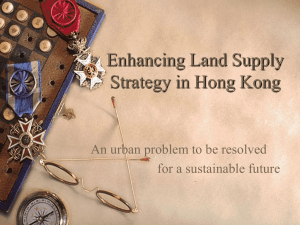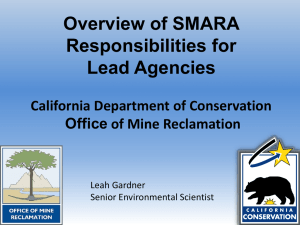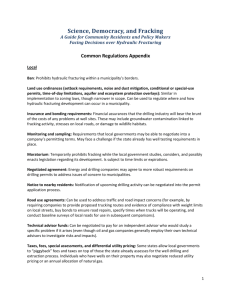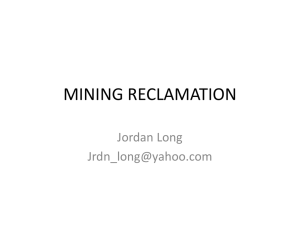Protocol Outline_Unconventional Shale Oil and Gas
advertisement
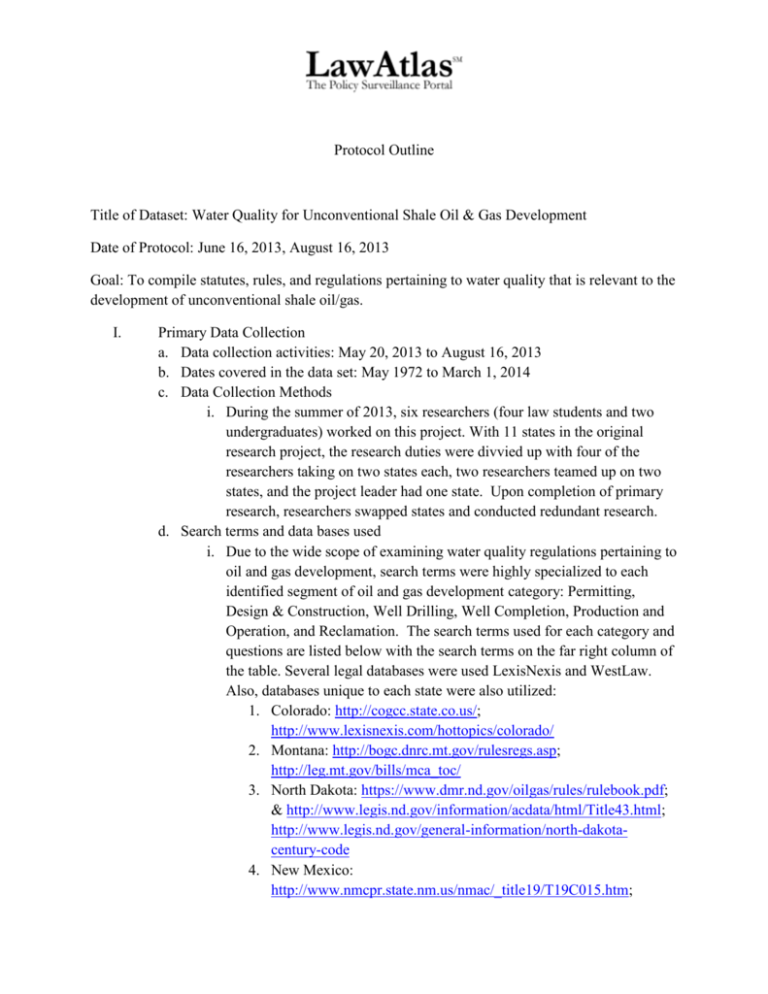
Protocol Outline Title of Dataset: Water Quality for Unconventional Shale Oil & Gas Development Date of Protocol: June 16, 2013, August 16, 2013 Goal: To compile statutes, rules, and regulations pertaining to water quality that is relevant to the development of unconventional shale oil/gas. I. Primary Data Collection a. Data collection activities: May 20, 2013 to August 16, 2013 b. Dates covered in the data set: May 1972 to March 1, 2014 c. Data Collection Methods i. During the summer of 2013, six researchers (four law students and two undergraduates) worked on this project. With 11 states in the original research project, the research duties were divvied up with four of the researchers taking on two states each, two researchers teamed up on two states, and the project leader had one state. Upon completion of primary research, researchers swapped states and conducted redundant research. d. Search terms and data bases used i. Due to the wide scope of examining water quality regulations pertaining to oil and gas development, search terms were highly specialized to each identified segment of oil and gas development category: Permitting, Design & Construction, Well Drilling, Well Completion, Production and Operation, and Reclamation. The search terms used for each category and questions are listed below with the search terms on the far right column of the table. Several legal databases were used LexisNexis and WestLaw. Also, databases unique to each state were also utilized: 1. Colorado: http://cogcc.state.co.us/; http://www.lexisnexis.com/hottopics/colorado/ 2. Montana: http://bogc.dnrc.mt.gov/rulesregs.asp; http://leg.mt.gov/bills/mca_toc/ 3. North Dakota: https://www.dmr.nd.gov/oilgas/rules/rulebook.pdf; & http://www.legis.nd.gov/information/acdata/html/Title43.html; http://www.legis.nd.gov/general-information/north-dakotacentury-code 4. New Mexico: http://www.nmcpr.state.nm.us/nmac/_title19/T19C015.htm; http://public.nmcompcomm.us/nmpublic/gateway.dll/?f=templates &fn=default.htm 5. New York: http://www.dec.ny.gov/regulations/regulations.html, Chapter V - Resource Management Services & Chapter X Division of Water; http://public.leginfo.state.ny.us/menugetf.cgi?COMMONQUERY =LAWS 6. Ohio: http://codes.ohio.gov/ 7. Pennsylvania: http://www.legis.state.pa.us/WU01/LI/LI/US/HTM/2012/0/0013.H TM; http://www.pacode.com/secure/data/025/chapter78/chap78toc .html 8. Texas: http://www.rrc.state.tx.us/rules/rule.php; http://www.statutes.legis.state.tx.us/ 9. Utah: http://www.rules.utah.gov/; http://le.utah.gov/UtahCode/title.jsp 10. West Virginia: http://www.legis.state.wv.us/WVCODE/Code.cfm; 11. Wyoming: http://wogcc.state.wy.us/; http://legisweb.state.wy.us/titles/statutes.htm e. Search Terms for Each Category Search Terms: Water Quality – Permitting, Design, and Construction Public Description Search Terms 1(P) Is baseline water source testing required? Yes Yes, but only for injection wells Only In Specific Jurisdictions No Baseline water source testing “baseline” “monitoring” “testing” “sampling” “water” 1.1(C) What location requirements for water source testing are specified? None Distance from Operations Other Location requirements for water source testing “baseline” “monitoring” “testing” “sampling” “water” 1.2(C) What water sources must be tested? Not specified Water Wells Springs Surface Water Other Water sources to be tested “baseline” “monitoring” “testing” “sampling” “water” Question Question Possible Answers Water source testing parameters “baseline” “monitoring” “testing” “sampling” “water” “chemical” “biological” “physical” Water source testing techniques “baseline” “monitoring” “testing” “sampling” “water” Follow-up water source testing “baseline” “monitoring” “testing” “sampling” “water” Comparison to baseline testing “baseline” “monitoring” “testing” “sampling” “water” Yes No Public disclosure of test results “baseline” “monitoring” “testing” “sampling” “water” “disclosure” “presumption of liability” “liability” “presumption of liability” “liability” 1.3(C) What parameters for water source testing are specified? 1.4(C) What techniques for water source testing are specified? 1.5(C) Is follow-up water source testing required? 1.5.1(G) Does follow-up testing use identical requirements to baseline testing? 1.6(C) Are water source testing results publicly disclosed? 2(P) Is there a presumption of liability against operators when pollution is found in a nearby water source? Yes No Presumption of liability for pollution of nearby water sources 2.1(C) At what distance from oil and gas operations 0 feet - 1,500 feet 1,501 feet - 2,500 feet 2,501 feet - 5,000 feet More than 5,000 feet Presumption of liability distance Not Specified Chemical Indicators Biological Indicators Physical Indicators Not Specified Number of Samples Method Used Yes No Yes No does this presumption apply? Variable 2.2(C) What are the defenses/exem ptions for operator liability? Baseline testing Water source owner refused baseline testing Other Defenses/excep tions for presumption of liability “presumption of liability” “liability” “defense” “exemption” 3(P) What subsurface features are operators required to identify? Other Aquifers Seismic Hazards Subsurface feature identification “aquifer” “underground” “subsurface” “seismic” 3.1(C) Are there any exemptions? Yes No Subsurface identification exemptions “aquifer” “underground” “subsurface” “seismic” 4(P) What are the siting restrictions for oil and gas wells? Other Exclusion Areas Water Source Setback Restrictions Well-density Restrictions Oil and gas well siting restrictions “siting” “spacing” “well-density” “setback” “location” 4.1(C) Are there specific siting restrictions if the well is to be hydraulically fractured? Well fracturing siting restrictions “siting” “spacing” “well-density” “setback” “location” “hydraulic fracture” “horizontal” Yes No 4.2(C) Are there any exceptions/wai vers to the siting restrictions? Yes No Exceptions/waiv ers to well siting restrictions “siting” “spacing” “well-density” “setback” “location” “exemption” “waiver” 5(P) What are the siting restrictions None Other Exclusion Areas Material storage siting restrictions “pit” “tank” “pool” specific to pits, holding tanks, and other material storage? “pond” Water Source Setback Restrictions 5.1(C) Are there any exceptions/wai vers to these restrictions? Yes No Exceptions/waiv ers to material storage siting restrictions “pit” “tank” “pool” “pond” 6(P) What are the siting restrictions specific to injection wells? Other Exclusion Areas Water Source Setback Restrictions Well-density Restrictions Injection well siting restrictions “injection” “class II” 6.1(C) Are there any exceptions/wai vers to these restrictions? Yes No Exceptions/waiv ers to injection well siting restrictions “injection” “class II” 7(P) Is there any limitation on the size of the well pad disturbance? Well-pad size limitations Oil and Gas, Disturbance, acre/mile, limit, well site, well pad, size 8(P) Other design limitations? Design limitations Oil and Gas, Prohibited, Ban, Limit, 9(P) What water quality protection technologies and practices are recommended or required? Closed-Loop Drilling Pit Liners Other Best Management Practices Storage Tank Requirements Other None Identified 10(P) Who must operators notify as part of the permitting process? State Regulatory Agency Local Government Surface owners Mineral Owners Neighboring Landowners Yes No Yes No Oil and Gas, Closed-Loop Drilling, Holding containers, Best Required Management technologies/pr Practices, actices Storage Tank, Pit liner, Recommended practices Operator notification requirements “notify” “notification” Other 11(P) Is the source or type of water to be used in operations regulated? Yes No Water used in operations 12(P) Do operators need a stormwater/ero sion mitigation plan as part of the permitting process? Yes Varies by Size of Development No Stormwater/ero sion mitigation “stormwater” “erosion” 13(P) Is a reclamation plan required to receive a permit to drill? Yes No Reclamation plan requirement for permit “reclamation” “abandonment” “plugging” “permit” Search Terms: Water Quality – Well Drilling Question Number Question 1(P) Does your state specify well-bore integrity standards for drilling? 2(P) Does your state require verification that well-bore surface casing was implemented properly? 3(P) Are operators required to use air or freshwater-based drilling fluid when drilling through fresh water aquifers? Possible Answers Yes No Yes No Air Freshwater-based drilling fluid Both Neither Public Description Search Terms Specifies wellbore integrity standards well bore, well-bore, drilling Surface casing surface casing Drilling through fresh-water aquifers groundwater, drinking water, fresh water, aquifers, air cooling, drilling fluid 4(P) When is well-bore cementing required? 4.1(C) Is stage cementing allowed as an alternative when standard cement casing is uneconomical? 5(P) Is blowout prevention equipment (“BOPE”) required? 6(P) Are cement-bond logs required to be recorded and filed? 6.1(C) With whom must the logs be filed? 7(P) Does your state specify mechanical integrity testing requirements? 7.1(C) Is annulus pressure monitoring and testing required? Subsurface conditions unknown Subsurface conditions known Other Yes No Yes No Yes No Regulatory authority Well operator Other Yes No Yes No Conditions necessitating cement casing well-bore cementing, casing Stage cementing Stage cementing Blowout prevention equipment blowout prevention equipment, BOPE Cement-bond logs cement-bond logs, recording, monitoring Where to find the logs monitoring, recording, [name of state regulatory authority], cement bond logs Mechanical integrity testing mechanical integrity, standards, testing, monitoring Annulus pressure testing Annulus, annular, pressure, testing, monitoring 7.2(C) Does the state require compliance with American Petroleum Institute recommending practices for testing? 8(P) Does your state specify a compliance reporting process during well drilling? Yes No API RP compliance American Petroleum Institute, recommendin g practices, API RP, testing Yes No Compliance requirements reporting, compliance, monitoring Who is responsible for compliance reporting, compliance, monitoring, (name of regulatory authority) Horizontal-drilling requirements Horizontal drilling Horizontal-drillingrequirement specifications horizontal drilling, well site spacing, bottom-hole, permitting Operator files reports Regulators inspect well site Other 8.1(C) What is the process? 9(P) Does your state specify horizontal drilling requirements? 9.1(C) What horizontal-drilling requirements must an operator follow? Yes No Spacing requirements Bottom-hole requirements Permitting requirements Search Terms: Water Quality – Well Completion Question Number 1(P) Question Is public disclosure of chemicals/additives in fracturing fluid required? Possible Answers Yes No Public Description Search Terms Disclosure of chemicals in fracturing fluid Detailed information Stimulation fluid source Additive type Concentration rates Chemical compound name Chemical Abstract Service (CAS) number Percentage by weight Percentage by volume Pounds per gallon Gallons per thousand gallons Parts per million / parts per billion Disclosure Trade names Hydraulic fracturing fluid Disclosure Oil and Gas 1.1(C) When are operators required to disclose chemicals/additives in fracturing fluid? Before Use Within 30 days of use Within 31-60 days of use Other Timing of chemical disclosure 1.2(C) Are operators required to report the total volume of fracturing fluids used? Yes No Fluid volume reporting 1.3(C) Is disclosure of concentration of chemicals/additives in the fracturing fluid required? Overall Chemical/Additive Concentration Individual Chemical/Additive Disclosure of concentration of chemicals/additiv es in fracturing fluid Before well simulation As soon as possible No later than Days following completion Days after completion Detailed information Stimulation fluid source Additive type Concentration rates Chemical compound name Chemical Abstract Service (CAS) number Percentage by weight Percentage by volume Pounds per gallon Gallons per thousand gallons Parts per million / parts per billion Disclosure Oil and gas Hydraulic fracturing Fracturing fluid Well completion Proposed concentration Each additive Overall concentration Percentage by weight Concentrations None 1.4 (C) Is there an exemption from disclosure requirements for trade secrets? Yes No 1.4.1 (G) Who may access the trade secret information? Oil & Gas State Agency Other State Agency Health Care Professionals Other Nobody 1.5 (C) How does the public access disclosure information? State website Fracfocus.org Other 2(P) Does your state regulate the reuse and/or recycling of flowback/produced water at well completion? Encourages reuse Requires reuse Specifies conditions of reuse No Percentage by volume Pounds per gallon Gallons per thousand gallons Parts per million / parts per billion Disclosure Oil and gas Hydraulic fracturing Fracturing fluid Well completion Exemptions for trade secret Disclosure to specific agencies or others Public access to disclosure information Reuse or recycling of water Trade Secret Privileged information Confidential Protection Exempt Trade secret Emergency Trade secret exemption Public health official Diagnosis or treatment Health care State agency Oil and gas commission Public access State website Fracfocus Access information Feasible Solids removal equipment Drilling fluid waste Encourages the recycling of drilling Drilling fluids intended for recycling Recycle of flowback Reuse for fracturing operations Well completions Oil and gas Hydraulic fracturing fluid 2.1(C) 3(P) 4.1(C) Does your state require reporting of the volume of reused/recycled water? Does the state have requirements for the collecting, holding, and disposing of flowback water? What possible methods of disposal does the state allow for flowback water? Reporting of water reuse/recycle Yes No Yes No Class II well Commercial waste disposal facility Land treatment/applicati on Pits/tanks Total volume of recycled Collecting, holding, and disposing of flowback water Well stimulation fluid Hydraulic fracturing fluid Storage Protective of groundwater Tanks Lined pits Migratory birds Oil and gas Possible methods of disposal of flowback water Class II well Commercial waste disposal facility Land treatment/application Pits Tanks Road spreading Land farming Disposal of well stimulation fluid Search Terms: Water Quality – Production & Operations Question Number 1(P) Question Does the state have ongoing well inspection/monitoring requirements? Possible Answers Yes No Public Description Search Terms Well inspection requirements (Westlaw) “oil and gas, inspection,” (within regulations) “inspections,” “monitoring” 1.1(C) Does the state have frequency requirements for well inspections? Yes No Well inspection frequency requirements “well inspection, frequency,” “frequency requirement” “inspections,” “monitoring” 1.2(C) Does the state have requirements for selfinspection/monitoring of wells? Yes No Self-inspection requirements “inspection,” “reporting,” “monitoring” 2(P) What authority does the state’s governing agency have regarding inspection/monitoring of oil and gas sites? Right to inspect Right of entry Access to well records Other Agency authority to inspect “inspections,” “agency authority to inspect” Does the state regulate the reuse and/or recycling of produced water during well operations? Encourages reuse Requires reuse Specifies conditions of reuse No Reuse or recycling of water “oil and gas, recycled water,” “oil and gas, produced water” Reporting of water reuse/recycle “oil and gas, water volume,” “oil and gas, measurement of water” Collecting, holding, and disposing of produced water Drilling, disposal requirements, Collecting Holding Produced water 3(P) 3.1(C) 4(P) Does your state require reporting of the volume of reused/recycled water? Does the state have requirements for the collecting, holding, and disposing of produced water? Yes No Yes No Methods of collecting/holding produced water drilling, disposal requirements, produced water, pits, tanks, pipeline 4.2(C) What methods of disposal does the state allow for produced water? Class II Injection Well Evaporation Centralized Waste Treatment facility Publicly Owned Treatment Works Roadspreading Other Disposal of produced water drilling, disposal requirements, Class II Injection Well Evaporation Centralized Waste Treatment facility Publicly Owned Treatment Works Roadspreading 5(P) Does the state have requirements for reporting spills and accidents? Yes No Spills and accident reporting requirements oil and gas, spills and accident reports 5.1(C) Does the state require notification be given to the surface owner after a spill? Notification to surface owner after spill oil and gas, spills and accident reports, notification 5.2(C) Is the type of notification dependent on the type or volume of the spill or accident? Yes No Notification dependent on volume/type of spill oil and gas, spills and accident reports, notification 5.3(C) Is the reporting timeframe Yes Reporting time frame oil and gas, 4.1(C) What methods of collecting/holding produced water does the state allow? Pits Tanks Pipelines Other Yes No dependent on the type or volume of the spill or accident? 5.4(C) Are reporting requirements dependent on the type or volume of the spill or accident? 6(P) Does the state have requirements for the storage, handling, transportation, treatment, recycling, or disposal of Exploration and Production waste? No spills and accident reports, notification Yes No Reporting requirements dependent on type of spill oil and gas, spills and accident reports, notification Yes No Exploration and Production Waste Management “exploration and production waste,” “waste disposal” Search Terms: Water Quality – Reclamation Question Number 1(P) Question Is interim reclamation required? Possible Answers Public Description Search Term Yes No Interim reclamation Oil, gas, interim, reclamation, restoration, disturbed, remediate: These baseline search terms could/should be used for every child question below. abandoned, shut-in wells minimum 1.1(C) Is interim reclamation required for temporarily abandoned or shut-in wells? Yes No Interim reclamation during temporary abandonment 1.2(C) What is the minimum No time given Minimum timeframe within which interim reclamation must begin? 1.3(C) Is removal of debris required? Dependent on life cycle Less than 3 months 3 - 6 months Greater than 6 months to 1 year Greater than a year timeframe to begin interim work timeframe, land, surface, plugged, days, months, year Yes No Debris removal during interim reclamation debris, removal backfill, pits, holes 1.4(C) Is backfilling of unnecessary holes and pits required? Yes No Unnecessary holes & pits backfilled during interim 1.5(C) Must grasses, forbs, shrub and/or trees be planted? Yes No Planting during interim reclamation planting, vegetation, grasses, forbs, shrub, tree 1.5.1(G) Do the grasses, forbs, shrub, and/or trees have to be native to the surrounding area? Yes No Native plantings during interim reclamation planting, vegetation, grasses, forbs, shrub, tree, native, indigenous Reclamation plan requirement for permit Oil, gas, interim, reclamation, restoration, disturbed, remediate, application for permit to drill, plan 2(P) Is a reclamation plan required to receive a permit to drill? 3(P) Are financial assurances required for new wells in case proper reclamation is not achieved? Yes No Financial assurances required Oil, gas, financial, security, bond, assurance, surety, reclamation, restoration, remediate What is the financial assurance required for a single new well? $0 $1-5,000 $5001-10,000 $10,001-20,000 More than $20,000 Financial assurance required for a single well Oil, gas, financial, security, bond, assurance, single new well 3.1(C) Yes No 3.2(C) What is the financial assurance required to cover the entire state? $0; $1-5,000 $5001-10,000 $10,001-20,000 More than $20,000 Financial assurance requirement for statewide coverage Oil, gas, financial, security, bond, assurance, statewide, blanket 3.3(C) Is the financial assurance uniform regardless of the type of new well? Yes No Uniform financial assurances Oil, gas, financial, security, bond, assurance, uniform Oil, gas, final, reclamation, restoration, disturbed, remediate, plugged, abandoned: These baseline search terms could/should be used for every question below. Are final reclamation tasks required when a well is plugged and/or abandoned? Yes No Final reclamation tasks required 4.1(C) What is the timeframe for all final reclamation tasks to be completed? No time given Less than 3 months 3-6 months Greater than 6 months to 1 year Greater than a year Time to complete final reclamation tasks timeframe, tasks 4.2(C) Is removal of debris required? Yes No Debris removal during final reclamation debris, removal backfill, pits, holes 4(P) 4.3(C) Is backfilling of unnecessary holes and pits required? Yes No Unnecessary holes & pits backfilled during final reclamation 4.4(C) Must grasses, forbs, shrub and/or trees be planted? Yes No Planting during final reclamation planting, vegetation, grasses, forbs, shrub, tree 4.4.1(G) Do the grasses, forbs, shrub, and/or trees have to be native to the surrounding Yes No Native plantings during final planting, vegetation, grasses, forbs, 4.5(C) 4.6(C) II. area? reclamation Does the state require an evaluation of reclamation efforts before releasing the bond? Evaluation before releasing financial assurance evaluation, release, return, forfeiture, state inspection Factors when evaluating final reclamation evaluation, release, return, forfeiture, state inspection, vegetative cover, percentage, weed control, stormwater management, water, pits, holes, backfilled, filled, removed What factors are considered when evaluating final reclamation? Yes No Vegetative covers of disturbed lands Weed control Stormwater controls Removal or burial of pits Other Not specified shrub, tree, native, indigenous Coding a. Background information i. The initial two weeks of the research project consisted of providing a framework and opportunities for the researchers to gain subject matter knowledge. An introductory meeting was held with the six researchers to provide information about the scope of the project and hand out initial background reading assignments about unconventional oil and gas development. The entire team then received a presentation from a University of Colorado Law professor about shale gas and oil development and impacts. Each research was then tasked with collecting grey literature pertaining to water quality and shale oil/gas development. ii. Throughout the course of the research project, Google Drive was utilized to collect and share information. A general outline of the stages of oil and gas development and potential statutory and regulatory subjects was built for the researchers. The outline was a starting point in order to identify and develop proper water quality questions. The stages and potential statutory and regulatory subjects had been developed in coordination with our partners, the Environmentally Friendly Drilling program. Six stages were initially identified, and each stage was assigned to a researcher. The potential statutory and regulatory subjects for each stage were analyzed by the researchers to determine their adequacy; subjects were added and removed depending on that research. Potential statutory and regulatory subjects were presented to entire group and finalized. At this point, each researcher was assigned a number of states and began collecting statutes and regulations for their states that corresponded with the finalized subjects. Upon completion of this initial collection, the researchers swapped states and checked, at a minimum, five questions per state as a quality control measure. Simultaneously, while this work was being conducted, each researcher was developing draft questions for the LawAtlas database. The drafts were written utilizing the Workbench User Guide. Finally, a day-long, group editing session was held to finalize the questions for the database. A group session was held to finalize the questions because each of the researchers had spent considerable amount of time concentrating on one stage of the oil and gas development process and because the process of collecting statutes and regulations for individual states had provided a basis for the nuances of regulatory structure across jurisdictions and development stages. iii. Once the questions were coded and entered into LawAtlas, each researcher began transferring the appropriate statutes and regulations into the legal text box and answering the questions. During this process, questions and answers were edited with consent from the entire group. The nuances of state laws and regulations pertaining to water quality required tinkering with the questions and answers in order to properly capture the information. b. Coding methods i. The coding is done on an individual basis with each researcher responsible for assigned states. Upon completion of coding, the researchers swapped states and a minimum of five questions were randomly double checked. If concerns arose during this portion, questions and suggestions were shared with the entire team. Weekly meetings were also held to hammer through any discrepancies and concerns. c. Test with Naïve Coder i. Naïve coders were brought on toward the end of the coding process to code 13 randomly selected records (15% of 88 records). Once the naïve coding was finished, the project leader analyzed the divergences between the original coder and the naïve coder. Conversations were held with the naïve coders to better assess the divergences and clarification to questions and answers followed.


